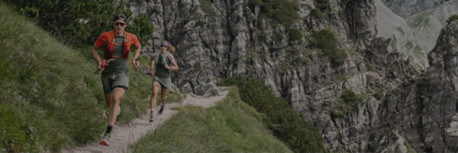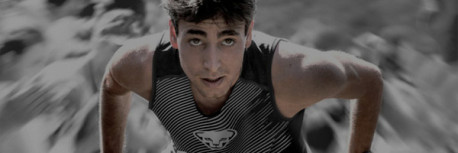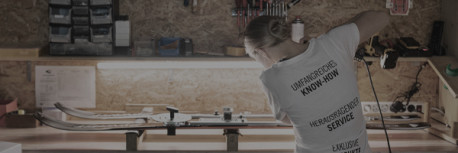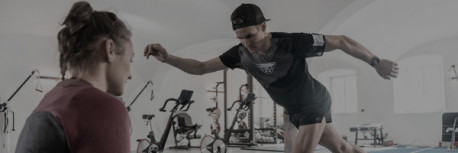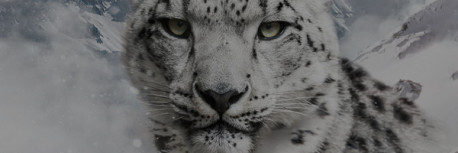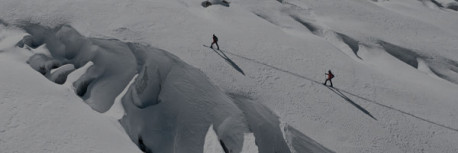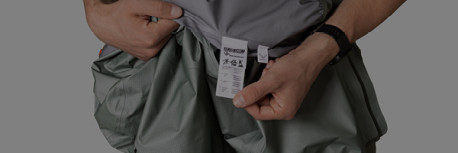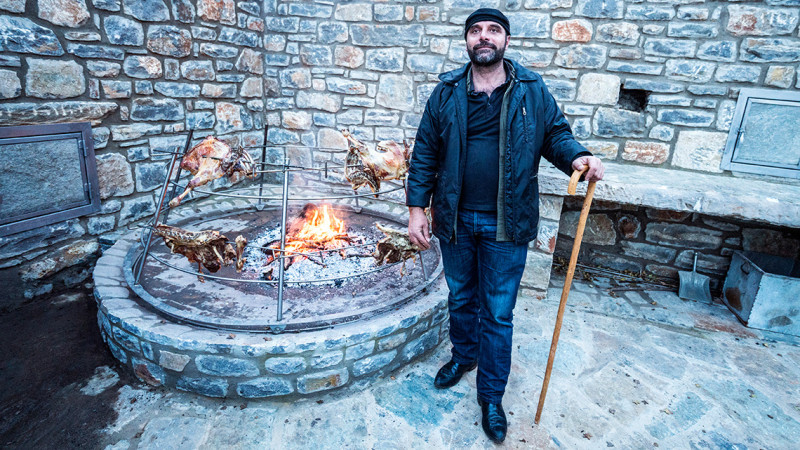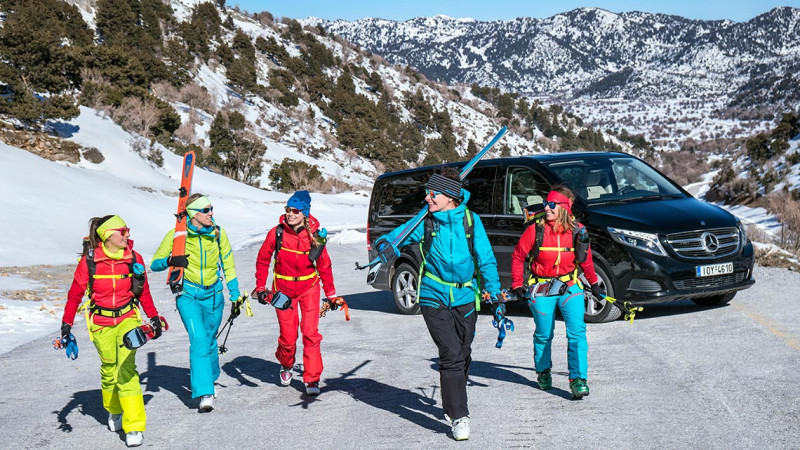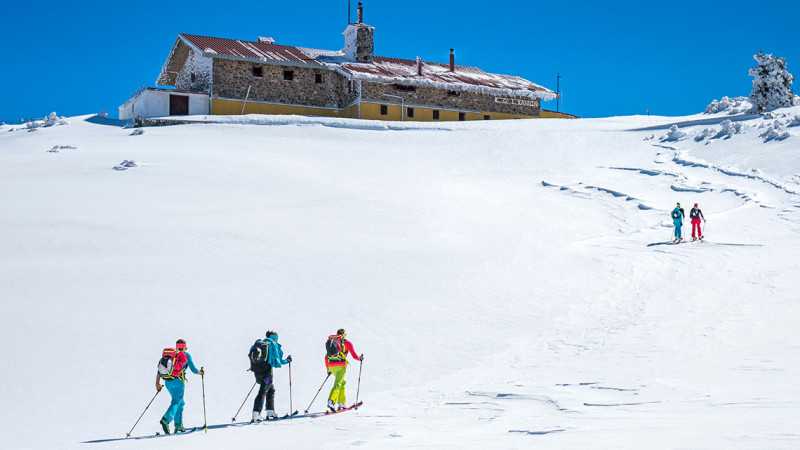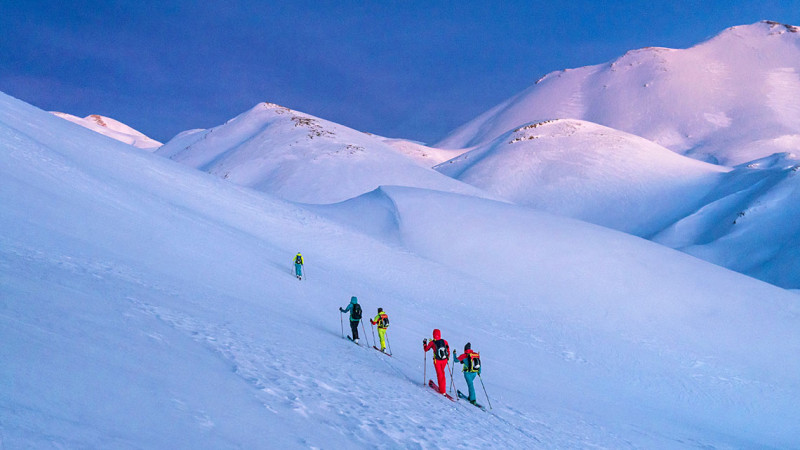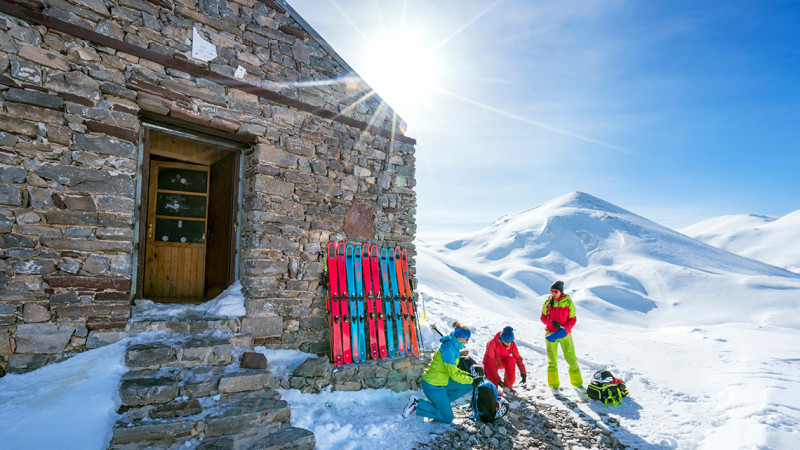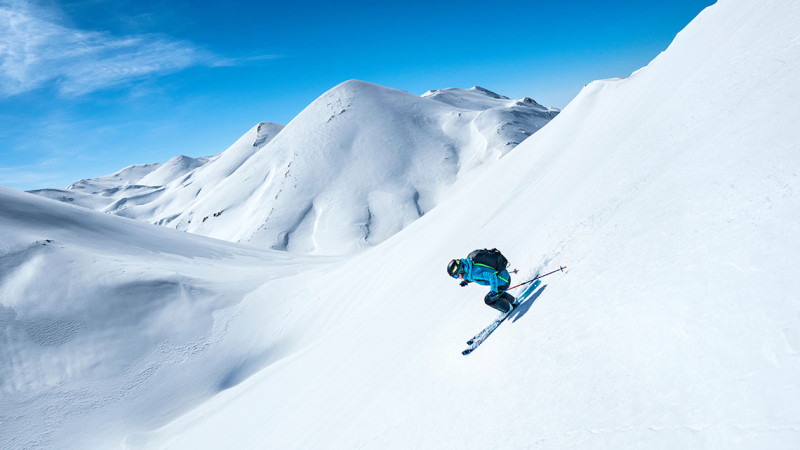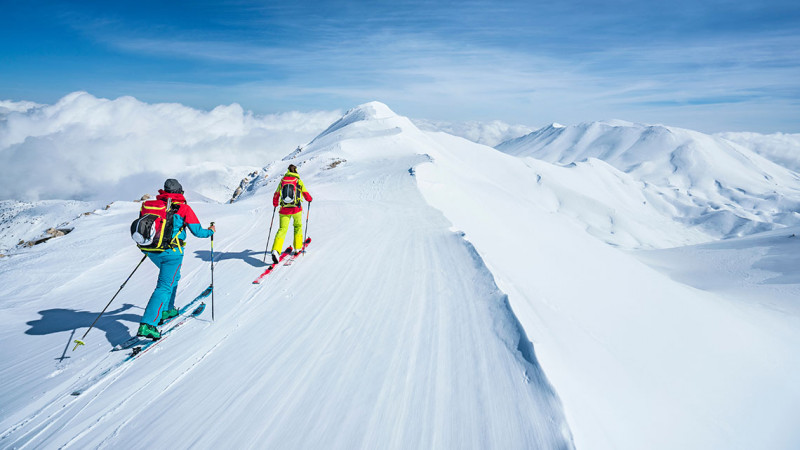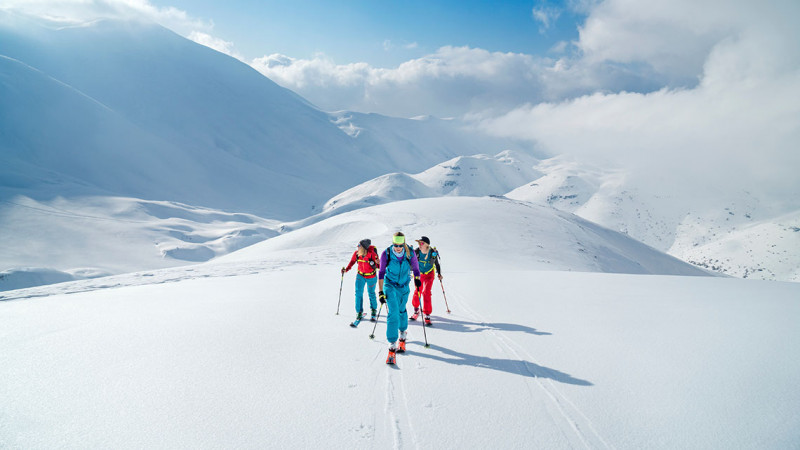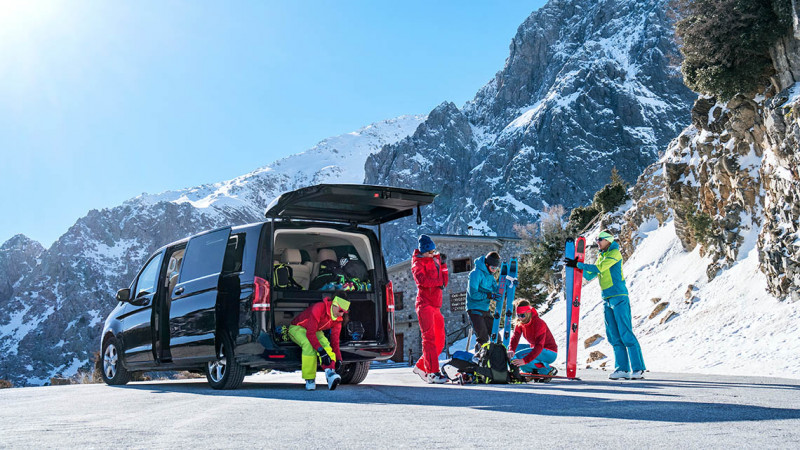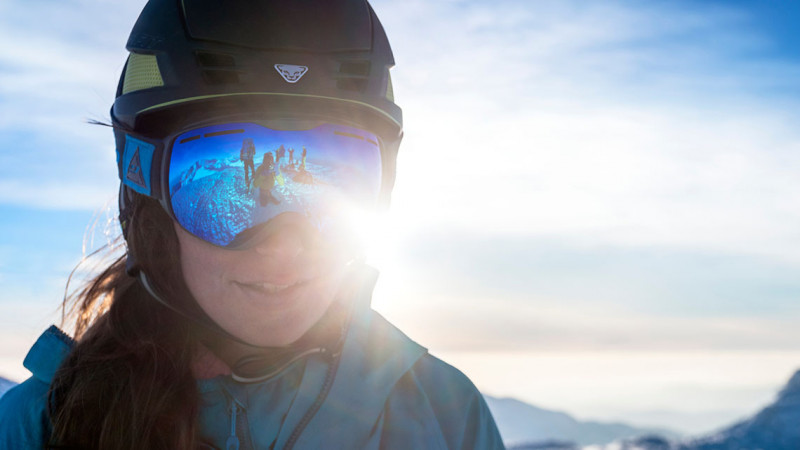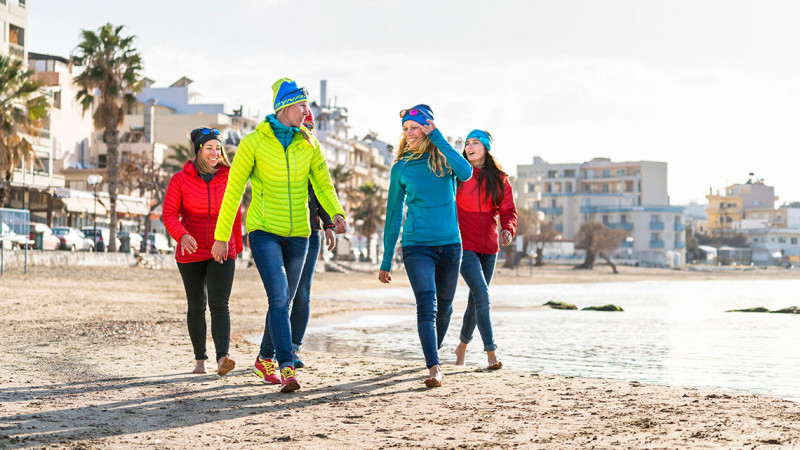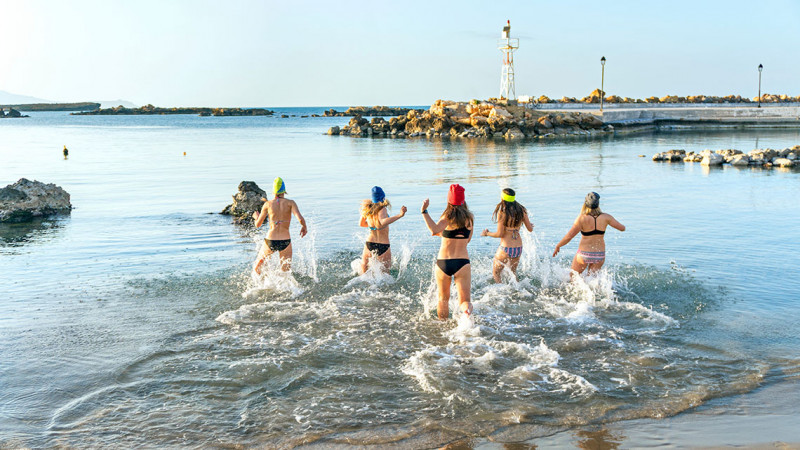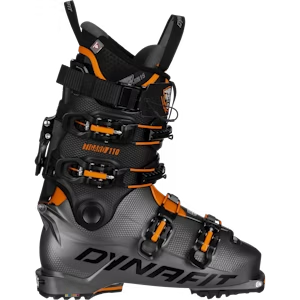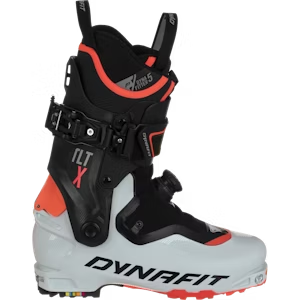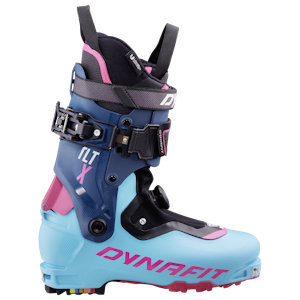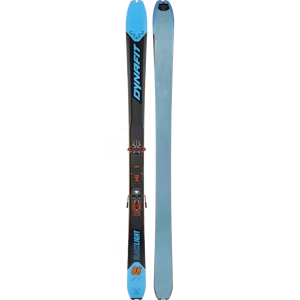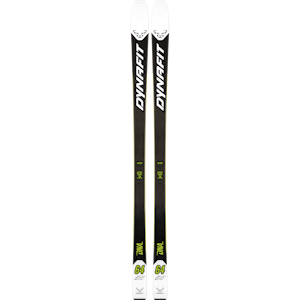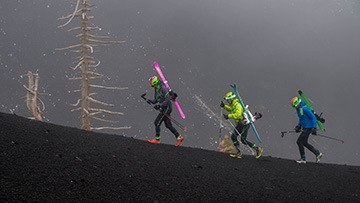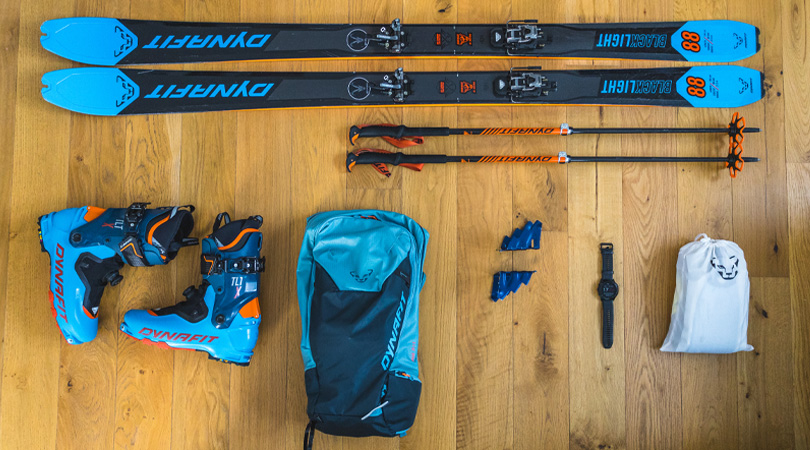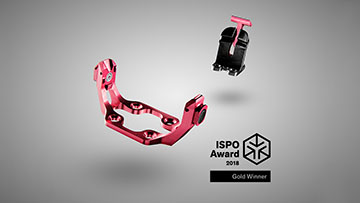Endless sandy beaches, olive groves, crystal clear waters, wild canyons, secluded bays and ancient archeological diggings – that is Crete as you see it in tourist brochures. Ah, but Crete harbors a hidden diamond in the raw: Between Lekfa Ori in the west and the Ida mountains in the center is a seemingly endless snow-covered expanse awaiting amazing and exotic ski tours. At first, ski touring on Crete seems a little odd perhaps, but that is precisely why it is so attractive to us five women. The “us” here are Sibylle, Emy, Steffi, Alessa and myself, Chrissi – all colleagues at Dynafit, crazy for mountains and ready to discover Crete’s mystical alpine world on touring skis.
Sometimes you have to abandon your comfort zone, dare an adventure, be ready for something new. Let the surreal become reality and simply live your dream.
Arriving in Chania, we are the strange ones among the travelers – with skis in hand, we get a few long stares as we leave the airport. In short order, we are in the car with our guide, George. With windows open, a slightly salty ocean breeze wafts past us. It smells more like spring that winter. Greek guitar music streams from the radio as accompaniment for our three-hour drive to Omalos and puts us in the mood for our adventure. Reaching about 900 meters (2,953 feet) above sea level, we catch our first glimpse of snow beside the road. Villages, not here! We continue down the road, alone, until our driver, Nikos, parks the car in front of a barely lit little stone house. Fully loaded down, we open the door to our abode for the first night. A fire crackles in the fireplace, the owner is waiting for us.
Vegetable soup, lamb, salad with feta cheese, tsatsiki and rice-filled cabbage rolls are already ready for us. For dessert, there is yogurt with honey and, of course, Raki. We fully enjoy it while we discuss our tour with George. On the first two days, we are to cross the Lefka Ori mountains from west to east. Forty kilometers (25 miles) and 3,300 meters of climbing (9,843 feet) await us. We are to overnight in a bivouac hut…. Bivouac hut? We had not heard mention of that during our preparation! We are to carry a lightweight sleeping bag for the hut and provisions for one day – all of us women start to feel a little uneasy. We had only brought super thin silk sleeping bag liners and daypacks. A night in a stone hut without electricity or water in a thin bag liner? Just thinking about this created a little panic in our group. But we couldn’t change any of that at this point. During this first night we then gained a bit of an impression of what was to come. Cold, clammy bedding without any insulation didn’t really keep us warm. The next morning we awoke with heavy legs and chilled joints in our ski clothes. But our first glimpse out the window at the white mountain Lefka Ori made up for it all, and we started to get excited.
Harscheisen oder Steigeisen?
Ski crampons or traditional crampons?
Bluebird weather and the first warm rays of the sun greeted us on the northern end of the Samaria gorge. This 17-kilometer-long gorge (10.5 miles) is the longest in Europe and marks the starting point of our ski tour. In the summer, the street that leads to the gorge is lined with tour buses, George says. Today, we don’t see a soul. After just a few meters of climbing, the breathtaking view over the Libyan Sea to the south opens up before us. The north-facing slopes of the Lefka Ori mountains glisten with a silvery glow. What appears to be a metal coating is brightly shimmering ice, which we were to get well acquainted with in the next few days – more than we would have preferred.
From the Kalergi Hut (the only staffed hut in Lefka Ori), we head up and over the Melidau peak toward the Katsiveli Hut where we overnight. The first night is breathtaking but long and strenuous. We enjoy the untouched pristine beauty of nature and total seclusion. It is difficult between these soft snowy knolls that look so much alike to keep our orientation. There are no summit crosses or other markings in sight. Instead, there is ice, a lot of ice. Sometimes we feel a bit like Bambi first learning to walk. Even the ski crampons don’t offer enough traction. Thus, our recommendation: Traditional crampons are part of the mandatory equipment for any ski trip on Crete. After eight hours counting only travel time, including two in the dark, we finally reach the bivouac hut.
Three cheers for Greek hospitality!
Nikos, a friend of our guides, is already waiting for us with steaming cinnamon herbal tea. On the small gas stove, a fresh vegetable soup is simmering, and the thermometer in the hut indicates a cozy 10 degrees Celsius (50 Fahrenheit). Raise one to Nikos! Our second surprise following the soup is a large portion of Spaghetti Bolognese. Warm blankets and a hot water bottle for each of us ensure perhaps the coziest night of our trip. Three cheers for Greek hospitality!
Invigorated and well rested, we head over Svourichti on the second day to Mikros Trocharis at 2,410 meters (7,907 feet), the second-highest summit of Lefka Ori. The final ascent to Fanari ends with a long descent to the Niato Plateau. In sum, the first two days are about steep climbs, fantastic descents on firn snow, long traverses, and breathtaking landscapes. What impresses me is the compact snowpack. Up until now, we haven’t seen any debris cones although the sun heats up during the day to 10 degrees (50 F) and bakes the slopes relentlessly. George says, “Since his first ski tour in 1996, I have only seen two avalanches.” For us, hard to believe, but all the better!
The cradle of Zeus
We ski into the valley on the third day, in the direction of the Psiloritis Massif in the Ida mountains. If you believe Greek mythology, this is the birthplace of Zeus, the king of the gods. Between the lemon and orange trees, grazing sheep are constantly blocking our way. Soon, however, we reach the snowline and trade skis and skins for the car. Between the Sea of Crete to the north and the Libyan Sea we track upwards to the Migero Plateau and farther to Mt. Kourouna. The early season sun turns the narrow valley into a sauna.
A world filled with traditions and pure hospitality awaits us at the home of Pastor Andreas at his small farm in the middle of nowhere. And the best part: We meet people who share our passion of ski touring. On this day, the organizational committee of the ski mountaineering race Pierra Kreta has gathered at Papa Andreas’s place. We hit it off immediately! We sing, dance, play guitars, drink house wine and Raki until late in the night, and talk shop about the mountains and ski touring. The locals want to know more about us and skiing technique. They find our modern, technical apparel fascinating and tell us about a ski touring camp for kids. They tell us proudly about themselves and their mountains.
The final days of our trip take us to the ocean. Without skis or packs, we want to get to know the other side of Crete. On the way from the mountains to Chania, the meadows along the road get greener and greener as we go, and the orange and lemon trees shine brighter and brighter. Blossoms are out, the smell is like summer, and the air is warmer. Men sit on the edge of the street, play cards and drink coffee. The time seems to have stood still in some villages. At Chania’s harbor, we can finally dip our feet in the water. Balm for the feet we worked so hard. In the background, the white mountains of Lefka Ori gleam. A perfect ending of a ski tour in another, exotic world.
Endless sandy beaches, olive groves, crystal clear waters, wild canyons, secluded bays and ancient archeological diggings – that is Crete as you see it in tourist brochures. Ah, but Crete harbors a hidden diamond in the raw: Between Lekfa Ori in the west and the Ida mountains in the center is a seemingly endless snow-covered expanse awaiting amazing and exotic ski tours. At first, ski touring on Crete seems a little odd perhaps, but that is precisely why it is so attractive to us five women. The “us” here are Sibylle, Emy, Steffi, Alessa and myself, Chrissi – all colleagues at Dynafit, crazy for mountains and ready to discover Crete’s mystical alpine world on touring skis.
Sometimes you have to abandon your comfort zone, dare an adventure, be ready for something new. Let the surreal become reality and simply live your dream.
Arriving in Chania, we are the strange ones among the travelers – with skis in hand, we get a few long stares as we leave the airport. In short order, we are in the car with our guide, George. With windows open, a slightly salty ocean breeze wafts past us. It smells more like spring that winter. Greek guitar music streams from the radio as accompaniment for our three-hour drive to Omalos and puts us in the mood for our adventure. Reaching about 900 meters (2,953 feet) above sea level, we catch our first glimpse of snow beside the road. Villages, not here! We continue down the road, alone, until our driver, Nikos, parks the car in front of a barely lit little stone house. Fully loaded down, we open the door to our abode for the first night. A fire crackles in the fireplace, the owner is waiting for us.
Vegetable soup, lamb, salad with feta cheese, tsatsiki and rice-filled cabbage rolls are already ready for us. For dessert, there is yogurt with honey and, of course, Raki. We fully enjoy it while we discuss our tour with George. On the first two days, we are to cross the Lefka Ori mountains from west to east. Forty kilometers (25 miles) and 3,300 meters of climbing (9,843 feet) await us. We are to overnight in a bivouac hut…. Bivouac hut? We had not heard mention of that during our preparation! We are to carry a lightweight sleeping bag for the hut and provisions for one day – all of us women start to feel a little uneasy. We had only brought super thin silk sleeping bag liners and daypacks. A night in a stone hut without electricity or water in a thin bag liner? Just thinking about this created a little panic in our group. But we couldn’t change any of that at this point. During this first night we then gained a bit of an impression of what was to come. Cold, clammy bedding without any insulation didn’t really keep us warm. The next morning we awoke with heavy legs and chilled joints in our ski clothes. But our first glimpse out the window at the white mountain Lefka Ori made up for it all, and we started to get excited.
Ski crampons or traditional crampons?
Bluebird weather and the first warm rays of the sun greeted us on the northern end of the Samaria gorge. This 17-kilometer-long gorge (10.5 miles) is the longest in Europe and marks the starting point of our ski tour. In the summer, the street that leads to the gorge is lined with tour buses, George says. Today, we don’t see a soul. After just a few meters of climbing, the breathtaking view over the Libyan Sea to the south opens up before us. The north-facing slopes of the Lefka Ori mountains glisten with a silvery glow. What appears to be a metal coating is brightly shimmering ice, which we were to get well acquainted with in the next few days – more than we would have preferred.
From the Kalergi Hut (the only staffed hut in Lefka Ori), we head up and over the Melidau peak toward the Katsiveli Hut where we overnight. The first night is breathtaking but long and strenuous. We enjoy the untouched pristine beauty of nature and total seclusion. It is difficult between these soft snowy knolls that look so much alike to keep our orientation. There are no summit crosses or other markings in sight. Instead, there is ice, a lot of ice. Sometimes we feel a bit like Bambi first learning to walk. Even the ski crampons don’t offer enough traction. Thus, our recommendation: Traditional crampons are part of the mandatory equipment for any ski trip on Crete. After eight hours counting only travel time, including two in the dark, we finally reach the bivouac hut.
Three cheers for Greek hospitality!
Nikos, a friend of our guides, is already waiting for us with steaming cinnamon herbal tea. On the small gas stove, a fresh vegetable soup is simmering, and the thermometer in the hut indicates a cozy 10 degrees Celsius (50 Fahrenheit). Raise one to Nikos! Our second surprise following the soup is a large portion of Spaghetti Bolognese. Warm blankets and a hot water bottle for each of us ensure perhaps the coziest night of our trip. Three cheers for Greek hospitality!
Invigorated and well rested, we head over Svourichti on the second day to Mikros Trocharis at 2,410 meters (7,907 feet), the second-highest summit of Lefka Ori. The final ascent to Fanari ends with a long descent to the Niato Plateau. In sum, the first two days are about steep climbs, fantastic descents on firn snow, long traverses, and breathtaking landscapes. What impresses me is the compact snowpack. Up until now, we haven’t seen any debris cones although the sun heats up during the day to 10 degrees (50 F) and bakes the slopes relentlessly. George says, “Since his first ski tour in 1996, I have only seen two avalanches.” For us, hard to believe, but all the better!
The cradle of Zeus
We ski into the valley on the third day, in the direction of the Psiloritis Massif in the Ida mountains. If you believe Greek mythology, this is the birthplace of Zeus, the king of the gods. Between the lemon and orange trees, grazing sheep are constantly blocking our way. Soon, however, we reach the snowline and trade skis and skins for the car. Between the Sea of Crete to the north and the Libyan Sea we track upwards to the Migero Plateau and farther to Mt. Kourouna. The early season sun turns the narrow valley into a sauna.
A world filled with traditions and pure hospitality awaits us at the home of Pastor Andreas at his small farm in the middle of nowhere. And the best part: We meet people who share our passion of ski touring. On this day, the organizational committee of the ski mountaineering race Pierra Kreta has gathered at Papa Andreas’s place. We hit it off immediately! We sing, dance, play guitars, drink house wine and Raki until late in the night, and talk shop about the mountains and ski touring. The locals want to know more about us and skiing technique. They find our modern, technical apparel fascinating and tell us about a ski touring camp for kids. They tell us proudly about themselves and their mountains.
The final days of our trip take us to the ocean. Without skis or packs, we want to get to know the other side of Crete. On the way from the mountains to Chania, the meadows along the road get greener and greener as we go, and the orange and lemon trees shine brighter and brighter. Blossoms are out, the smell is like summer, and the air is warmer. Men sit on the edge of the street, play cards and drink coffee. The time seems to have stood still in some villages. At Chania’s harbor, we can finally dip our feet in the water. Balm for the feet we worked so hard. In the background, the white mountains of Lefka Ori gleam. A perfect ending of a ski tour in another, exotic world.
Endless sandy beaches, olive groves, crystal clear waters, wild canyons, secluded bays and ancient archeological diggings – that is Crete as you see it in tourist brochures. Ah, but Crete harbors a hidden diamond in the raw: Between Lekfa Ori in the west and the Ida mountains in the center is a seemingly endless snow-covered expanse awaiting amazing and exotic ski tours. At first, ski touring on Crete seems a little odd perhaps, but that is precisely why it is so attractive to us five women. The “us” here are Sibylle, Emy, Steffi, Alessa and myself, Chrissi – all colleagues at Dynafit, crazy for mountains and ready to discover Crete’s mystical alpine world on touring skis.
Sometimes you have to abandon your comfort zone, dare an adventure, be ready for something new. Let the surreal become reality and simply live your dream.
Arriving in Chania, we are the strange ones among the travelers – with skis in hand, we get a few long stares as we leave the airport. In short order, we are in the car with our guide, George. With windows open, a slightly salty ocean breeze wafts past us. It smells more like spring that winter. Greek guitar music streams from the radio as accompaniment for our three-hour drive to Omalos and puts us in the mood for our adventure. Reaching about 900 meters (2,953 feet) above sea level, we catch our first glimpse of snow beside the road. Villages, not here! We continue down the road, alone, until our driver, Nikos, parks the car in front of a barely lit little stone house. Fully loaded down, we open the door to our abode for the first night. A fire crackles in the fireplace, the owner is waiting for us.
Vegetable soup, lamb, salad with feta cheese, tsatsiki and rice-filled cabbage rolls are already ready for us. For dessert, there is yogurt with honey and, of course, Raki. We fully enjoy it while we discuss our tour with George. On the first two days, we are to cross the Lefka Ori mountains from west to east. Forty kilometers (25 miles) and 3,300 meters of climbing (9,843 feet) await us. We are to overnight in a bivouac hut…. Bivouac hut? We had not heard mention of that during our preparation! We are to carry a lightweight sleeping bag for the hut and provisions for one day – all of us women start to feel a little uneasy. We had only brought super thin silk sleeping bag liners and daypacks. A night in a stone hut without electricity or water in a thin bag liner? Just thinking about this created a little panic in our group. But we couldn’t change any of that at this point. During this first night we then gained a bit of an impression of what was to come. Cold, clammy bedding without any insulation didn’t really keep us warm. The next morning we awoke with heavy legs and chilled joints in our ski clothes. But our first glimpse out the window at the white mountain Lefka Ori made up for it all, and we started to get excited.
Ski crampons or traditional crampons?
Bluebird weather and the first warm rays of the sun greeted us on the northern end of the Samaria gorge. This 17-kilometer-long gorge (10.5 miles) is the longest in Europe and marks the starting point of our ski tour. In the summer, the street that leads to the gorge is lined with tour buses, George says. Today, we don’t see a soul. After just a few meters of climbing, the breathtaking view over the Libyan Sea to the south opens up before us. The north-facing slopes of the Lefka Ori mountains glisten with a silvery glow. What appears to be a metal coating is brightly shimmering ice, which we were to get well acquainted with in the next few days – more than we would have preferred.
From the Kalergi Hut (the only staffed hut in Lefka Ori), we head up and over the Melidau peak toward the Katsiveli Hut where we overnight. The first night is breathtaking but long and strenuous. We enjoy the untouched pristine beauty of nature and total seclusion. It is difficult between these soft snowy knolls that look so much alike to keep our orientation. There are no summit crosses or other markings in sight. Instead, there is ice, a lot of ice. Sometimes we feel a bit like Bambi first learning to walk. Even the ski crampons don’t offer enough traction. Thus, our recommendation: Traditional crampons are part of the mandatory equipment for any ski trip on Crete. After eight hours counting only travel time, including two in the dark, we finally reach the bivouac hut.
Three cheers for Greek hospitality!
Nikos, a friend of our guides, is already waiting for us with steaming cinnamon herbal tea. On the small gas stove, a fresh vegetable soup is simmering, and the thermometer in the hut indicates a cozy 10 degrees Celsius (50 Fahrenheit). Raise one to Nikos! Our second surprise following the soup is a large portion of Spaghetti Bolognese. Warm blankets and a hot water bottle for each of us ensure perhaps the coziest night of our trip. Three cheers for Greek hospitality!
Invigorated and well rested, we head over Svourichti on the second day to Mikros Trocharis at 2,410 meters (7,907 feet), the second-highest summit of Lefka Ori. The final ascent to Fanari ends with a long descent to the Niato Plateau. In sum, the first two days are about steep climbs, fantastic descents on firn snow, long traverses, and breathtaking landscapes. What impresses me is the compact snowpack. Up until now, we haven’t seen any debris cones although the sun heats up during the day to 10 degrees (50 F) and bakes the slopes relentlessly. George says, “Since his first ski tour in 1996, I have only seen two avalanches.” For us, hard to believe, but all the better!
The cradle of Zeus
We ski into the valley on the third day, in the direction of the Psiloritis Massif in the Ida mountains. If you believe Greek mythology, this is the birthplace of Zeus, the king of the gods. Between the lemon and orange trees, grazing sheep are constantly blocking our way. Soon, however, we reach the snowline and trade skis and skins for the car. Between the Sea of Crete to the north and the Libyan Sea we track upwards to the Migero Plateau and farther to Mt. Kourouna. The early season sun turns the narrow valley into a sauna.
A world filled with traditions and pure hospitality awaits us at the home of Pastor Andreas at his small farm in the middle of nowhere. And the best part: We meet people who share our passion of ski touring. On this day, the organizational committee of the ski mountaineering race Pierra Kreta has gathered at Papa Andreas’s place. We hit it off immediately! We sing, dance, play guitars, drink house wine and Raki until late in the night, and talk shop about the mountains and ski touring. The locals want to know more about us and skiing technique. They find our modern, technical apparel fascinating and tell us about a ski touring camp for kids. They tell us proudly about themselves and their mountains.
The final days of our trip take us to the ocean. Without skis or packs, we want to get to know the other side of Crete. On the way from the mountains to Chania, the meadows along the road get greener and greener as we go, and the orange and lemon trees shine brighter and brighter. Blossoms are out, the smell is like summer, and the air is warmer. Men sit on the edge of the street, play cards and drink coffee. The time seems to have stood still in some villages. At Chania’s harbor, we can finally dip our feet in the water. Balm for the feet we worked so hard. In the background, the white mountains of Lefka Ori gleam. A perfect ending of a ski tour in another, exotic world.
Endless sandy beaches, olive groves, crystal clear waters, wild canyons, secluded bays and ancient archeological diggings – that is Crete as you see it in tourist brochures. Ah, but Crete harbors a hidden diamond in the raw: Between Lekfa Ori in the west and the Ida mountains in the center is a seemingly endless snow-covered expanse awaiting amazing and exotic ski tours. At first, ski touring on Crete seems a little odd perhaps, but that is precisely why it is so attractive to us five women. The “us” here are Sibylle, Emy, Steffi, Alessa and myself, Chrissi – all colleagues at Dynafit, crazy for mountains and ready to discover Crete’s mystical alpine world on touring skis.
Sometimes you have to abandon your comfort zone, dare an adventure, be ready for something new. Let the surreal become reality and simply live your dream.
Arriving in Chania, we are the strange ones among the travelers – with skis in hand, we get a few long stares as we leave the airport. In short order, we are in the car with our guide, George. With windows open, a slightly salty ocean breeze wafts past us. It smells more like spring that winter. Greek guitar music streams from the radio as accompaniment for our three-hour drive to Omalos and puts us in the mood for our adventure. Reaching about 900 meters (2,953 feet) above sea level, we catch our first glimpse of snow beside the road. Villages, not here! We continue down the road, alone, until our driver, Nikos, parks the car in front of a barely lit little stone house. Fully loaded down, we open the door to our abode for the first night. A fire crackles in the fireplace, the owner is waiting for us.
Vegetable soup, lamb, salad with feta cheese, tsatsiki and rice-filled cabbage rolls are already ready for us. For dessert, there is yogurt with honey and, of course, Raki. We fully enjoy it while we discuss our tour with George. On the first two days, we are to cross the Lefka Ori mountains from west to east. Forty kilometers (25 miles) and 3,300 meters of climbing (9,843 feet) await us. We are to overnight in a bivouac hut…. Bivouac hut? We had not heard mention of that during our preparation! We are to carry a lightweight sleeping bag for the hut and provisions for one day – all of us women start to feel a little uneasy. We had only brought super thin silk sleeping bag liners and daypacks. A night in a stone hut without electricity or water in a thin bag liner? Just thinking about this created a little panic in our group. But we couldn’t change any of that at this point. During this first night we then gained a bit of an impression of what was to come. Cold, clammy bedding without any insulation didn’t really keep us warm. The next morning we awoke with heavy legs and chilled joints in our ski clothes. But our first glimpse out the window at the white mountain Lefka Ori made up for it all, and we started to get excited.
Ski crampons or traditional crampons?
Bluebird weather and the first warm rays of the sun greeted us on the northern end of the Samaria gorge. This 17-kilometer-long gorge (10.5 miles) is the longest in Europe and marks the starting point of our ski tour. In the summer, the street that leads to the gorge is lined with tour buses, George says. Today, we don’t see a soul. After just a few meters of climbing, the breathtaking view over the Libyan Sea to the south opens up before us. The north-facing slopes of the Lefka Ori mountains glisten with a silvery glow. What appears to be a metal coating is brightly shimmering ice, which we were to get well acquainted with in the next few days – more than we would have preferred.
From the Kalergi Hut (the only staffed hut in Lefka Ori), we head up and over the Melidau peak toward the Katsiveli Hut where we overnight. The first night is breathtaking but long and strenuous. We enjoy the untouched pristine beauty of nature and total seclusion. It is difficult between these soft snowy knolls that look so much alike to keep our orientation. There are no summit crosses or other markings in sight. Instead, there is ice, a lot of ice. Sometimes we feel a bit like Bambi first learning to walk. Even the ski crampons don’t offer enough traction. Thus, our recommendation: Traditional crampons are part of the mandatory equipment for any ski trip on Crete. After eight hours counting only travel time, including two in the dark, we finally reach the bivouac hut.
Three cheers for Greek hospitality!
Nikos, a friend of our guides, is already waiting for us with steaming cinnamon herbal tea. On the small gas stove, a fresh vegetable soup is simmering, and the thermometer in the hut indicates a cozy 10 degrees Celsius (50 Fahrenheit). Raise one to Nikos! Our second surprise following the soup is a large portion of Spaghetti Bolognese. Warm blankets and a hot water bottle for each of us ensure perhaps the coziest night of our trip. Three cheers for Greek hospitality!
Invigorated and well rested, we head over Svourichti on the second day to Mikros Trocharis at 2,410 meters (7,907 feet), the second-highest summit of Lefka Ori. The final ascent to Fanari ends with a long descent to the Niato Plateau. In sum, the first two days are about steep climbs, fantastic descents on firn snow, long traverses, and breathtaking landscapes. What impresses me is the compact snowpack. Up until now, we haven’t seen any debris cones although the sun heats up during the day to 10 degrees (50 F) and bakes the slopes relentlessly. George says, “Since his first ski tour in 1996, I have only seen two avalanches.” For us, hard to believe, but all the better!
The cradle of Zeus
We ski into the valley on the third day, in the direction of the Psiloritis Massif in the Ida mountains. If you believe Greek mythology, this is the birthplace of Zeus, the king of the gods. Between the lemon and orange trees, grazing sheep are constantly blocking our way. Soon, however, we reach the snowline and trade skis and skins for the car. Between the Sea of Crete to the north and the Libyan Sea we track upwards to the Migero Plateau and farther to Mt. Kourouna. The early season sun turns the narrow valley into a sauna.
A world filled with traditions and pure hospitality awaits us at the home of Pastor Andreas at his small farm in the middle of nowhere. And the best part: We meet people who share our passion of ski touring. On this day, the organizational committee of the ski mountaineering race Pierra Kreta has gathered at Papa Andreas’s place. We hit it off immediately! We sing, dance, play guitars, drink house wine and Raki until late in the night, and talk shop about the mountains and ski touring. The locals want to know more about us and skiing technique. They find our modern, technical apparel fascinating and tell us about a ski touring camp for kids. They tell us proudly about themselves and their mountains.
The final days of our trip take us to the ocean. Without skis or packs, we want to get to know the other side of Crete. On the way from the mountains to Chania, the meadows along the road get greener and greener as we go, and the orange and lemon trees shine brighter and brighter. Blossoms are out, the smell is like summer, and the air is warmer. Men sit on the edge of the street, play cards and drink coffee. The time seems to have stood still in some villages. At Chania’s harbor, we can finally dip our feet in the water. Balm for the feet we worked so hard. In the background, the white mountains of Lefka Ori gleam. A perfect ending of a ski tour in another, exotic world.
Ski Touring Crete
Ski Touring Crete
fsadfafs

